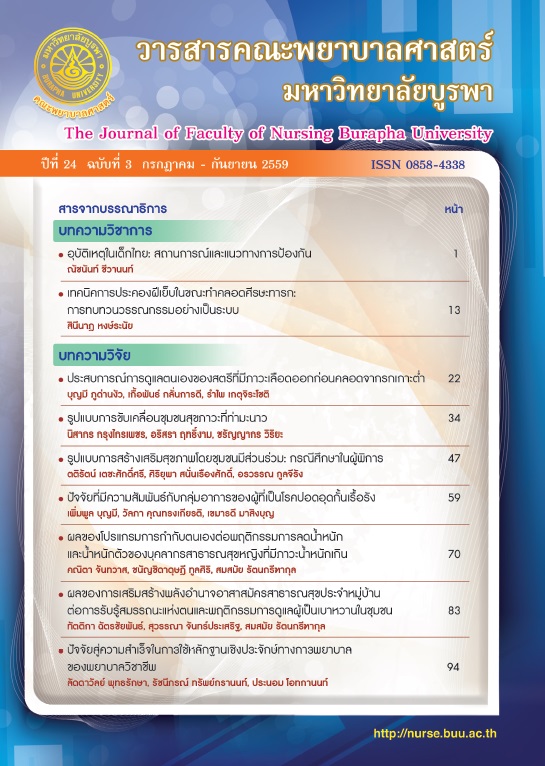เทคนิคการประคองฝีเย็บในขณะทำคลอดศีรษะทารก: การทบทวนวรรณกรรมอย่างเป็นระบบ
คำสำคัญ:
ระยะที่สองของการคลอด, การป้องกันการฉีกขาดฝีเย็บ, การใช้มือประคองฝีเย็บ, การไม่ใช้มือประคองฝีเย็บ, การทบทวนวรรณกรรมอย่างเป็นระบบ, Second stage of labor, safe/guarding the perineum, hands on technique, hand off/hands poised technique, a systematic reviewบทคัดย่อ
บทคัดย่อ
การศึกษาครั้งนี้มีวัตถุประสงค์เพื่อทบทวนวรรณกรรมอย่างเป็นระบบเกี่ยวกับเทคนิคการประคองฝีเย็บในขณะที่ศีรษะทารกกำลังคลอด (safe/guarding the perineum) ได้แก่ การใช้มือประคองฝีเย็บ (hands on technique) และการไม่ใช้มือประคองฝีเย็บ (hands off/hands poised technique) ที่มีต่อระดับการบาดเจ็บของฝีเย็บ ความเจ็บปวดที่ฝีเย็บ และอัตราการตัดฝีเย็บ ผู้ศึกษาได้สืบค้นเอกสารที่เกี่ยวข้องจากฐานข้อมูลทางอิเล็กทรอนิกส์ ได้แก่ ฐานข้อมูล Blackwell synergy, Science direct, Cochrane, OCLC, Highwire press, CINAHL, OVID, PubMed ที่ตีพิมพ์ระหว่างเดือนมกราคม ค.ศ. 2005 ถึงเดือนมีนาคม ค.ศ. 2015 และกำหนดเกณฑ์การคัดเลือกวรรณกรรมโดยใช้เกณฑ์การประเมินคุณภาพของหลักฐานตามกรอบแนวคิด PICOT
ผลการสืบค้นได้หลักฐานเชิงประจักษ์ที่สอดคล้องตามเกณฑ์การประเมินคุณภาพของหลักฐานตามกรอบแนวคิด PICOT จำนวน 5 ฉบับ ประกอบด้วยงานวิจัย 4 เรื่อง แบ่งเป็นงานวิจัยเชิงทดลอง 2 เรื่องและงานวิจัยกึ่งทดลอง 2 เรื่อง เอกสารอื่นๆ ที่ไม่ใช่งานวิจัย 1 เรื่อง ซึ่งเป็นการสังเคราะห์งานวิจัยด้วยวิธีวิเคราะห์อภิมาน (meta-analysis) สรุปผลจากหลักฐานเชิงประจักษ์ พบว่า 1) ระดับการฉีกขาดของฝีเย็บระหว่างกลุ่มที่ใช้มือประคองฝีเย็บกับกลุ่มที่ไม่ใช้มือประคองฝีเย็บไม่แตกต่างกัน แต่กลุ่มที่ใช้มือประคองฝีเย็บพบการฉีกขาดระดับ 3 มากกว่า ส่วนกลุ่มที่ไม่ใช้มือประคองฝีเย็บพบการฉีกขาดรอบท่อปัสสาวะมากกว่า 2) ความเจ็บปวดที่ฝีเย็บ กลุ่มที่ใช้มือประคองฝีเย็บมีความเจ็บปวดที่ฝีเย็บระดับเล็กน้อยถึงปานกลางใน 24 ชั่วโมงหลังคลอดและ 6 สัปดาห์หลังคลอดมากกว่ากลุ่มที่ไม่ใช้มือประคองฝีเย็บ 3) การตัดฝีเย็บ กลุ่มที่ใช้มือประคองฝีเย็บมีการตัดฝีเย็บมากกว่ากลุ่มที่ไม่ใช้มือประคองฝีเย็บ นั่นคือ เทคนิคการไม่ใช้มือประคองฝีเย็บสามารถลดอัตราการตัดฝีเย็บและลดความเจ็บปวดที่ฝีเย็บระดับเล็กน้อยถึงปานกลางใน 24 ชั่วโมงหลังคลอดและ 6 สัปดาห์หลังคลอดได้ดีกว่า
Abstract
This study aimed at systematically review all available literature to compare the hands on and hands poised techniques of perineal management during fetal head crowning whether they affected to level of perineal trauma, perineal pain and rates of episiotomy. The documents were searched from electronic databases including Blackwell Synergy, Science Direct, Cochrane, OCLC, Highwire Press, CINAHL, OVID, PubMed, published between January 2005 and March 2015. The criterion for selection was using the principles of a modified systematic literature review, quantitative, comparative and primary research studies; these were assessed for quality by using the PICOT framework.
The results of this systematic review reviewed that five studies were selected and outlined the importance of both techniques by using the PICOT framework; including two experimental researches, two quasi-experimental researches and one systematic review with meta-analysis. In conclusion, the results of these reviews were as follows: 1) hands on and hands poised techniques showed no difference in terms of the degree of perineal trauma. In the hands on group experienced a third degree trauma more than the hands poised group whereas in the hands poised group experienced periurethral tears more than the hands on group 2) there was a significant effect of hands poised technique on reducing of mild to moderate perineal pain within 24 hours and 6 weeks after delivery 3) hands poised technique showed a significant effect on decreasing rate of episiotomy. The finding suggested that hands poised technique could be preferable in terms of reducing rate of episiotomy and reducing of mild to moderate perineal pain within 24 hours and 6 weeks postpartum.





